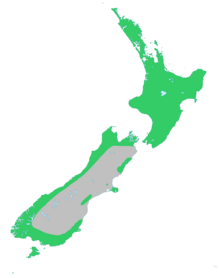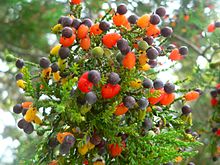Dacrycarpus dacrydioides
| Kahikatea | |
|---|---|

| |
| Mature kahikatea tree | |
| Scientific classification | |
| Kingdom: | Plantae |
| Clade: | Tracheophytes |
| Clade: | Gymnospermae |
| Division: | Pinophyta |
| Class: | Pinopsida |
| Order: | Araucariales
|
| Family: | Podocarpaceae |
| Genus: | Dacrycarpus |
| Species: | D. dacrydioides
|
| Binomial name | |
| Dacrycarpus dacrydioides (
de Laub. | |

| |
| Natural range of D. dacrydioides | |
| Synonyms[2] | |
Dacrycarpus dacrydioides, commonly known as kahikatea (from
In
Kahikatea seeds have fleshy structures called receptacles attached to them, which encourage birds such as kererū and tūī to eat them and disperse the seeds. The water storage ability of these structures may also act to protect seeds from drying out. It supports many smaller plants in its own branches, which are called epiphytes; 100 different species have been recorded on one tree alone.
Description
Kahikatea is a coniferous tree reaching a height of 50–65 m (164–213 ft), making it the tallest New Zealand tree,[3] with a trunk 1–2 m (3.3–6.6 ft) through. It has a 600 year life span and gains maturity after between 250 and 450 years.[4] Near the base of the tree, the roots are typically buttressed and grooved. Adult trees that grow in clusters develop interlocking root islands that may help prevents individual trees from falling during high winds.[5] The wood itself is odourless and white. The majority of the trunk is branchless—in adults around three quarters—and has grey or dark grey coloured bark which falls off thickly in flakes. Young adults have no branches in a third to a half of the trunk and have a conic shape.[2]
In juveniles the leaves are 3–7 (reaching 4 mm in young adults) by 0.5–1 mm and a dark green to red colour that come to a marked point. They are narrow, arranged in almost opposite pairs spreading away from a wider base, and curved like a scythe. In adulthood the leaves change dramatically and are a brown-green colour and just 1–2 mm long, waxy, and grow overlapping one another tightly.[2]
As a conifer, kahikatea has no flowers and instead has
-
Male cones with pollen
-
Female cones beginning to fruit
-
Ripe fruit
-
Young adult's conical growth habit
Phytochemistry
Several different glycosides have been isolated from the leaves; the tricetin 3’,5’-di-O-/β-glucopyranoside and 3’-0-β-xylopyranoside have been found only in kahikatea.[8] The receptacles and seeds have been found to contain anthocyanins, rare in gymnosperms, which it was suggested in one 1988 paper make the fruit as a whole more attractive to prospective animal dispersers.[9]
Taxonomy
The banks were completely clothed with the finest timber my eyes ever beheld, of a tree we had before seen, but only at a distance [...]. Thick woods of it were everywhere upon the banks, every tree as straight as a pine, and of immense size, and the higher we went the more numerous they were.
Kahikatea was first described in 1832 by the French botanist
Etymology
Dacrycarpus means tear shaped fruit, and the specific epithet dacrydioides is after its similarity to species in the genus Dacrydium.[2] Common names include kahikatea, from the Māori language, and white pine. Other Māori names recorded by 19th century ethnographers include: katea, kaikatea, koroī, kōaka, kahika, and the name kāī (for the young tree).[16]
Evolution
A 2022 study in
| |||||||||||||
Distribution and habitat
Kahikatea is
Ecology
Dispersal
Under optimal circumstances a mature kahikatea can produce 800 kilograms (1,800 lb) of fruit, equivalent to 4.5 million seeds, in a year. The fruit contains a special fleshy structure called a receptacle which helps attract birds such as the kererū, tūī, and bellbird, who then eat the fruit and disperse the seed elsewhere. One 2008 study in the New Zealand Journal of Ecology found a mean retention time of kahikatea seeds in kererū of 44.5 minutes.[20] It was suggested in a 1989 study that the high water content of the receptacle may also help protect the seeds, which are vulnerable to drying out, from dry conditions. It may also serve as a storage vessel for water.[4] The bluish seeds have very strong UV reflectance, which is visible to some species of birds.[21]
Epiphytes
Kahikatea can support a vast number of non-parasitic plants that live in its branches, called epiphytes. One 2002 study identified between 90 and 100 species occurring on one mature tree. This included 49 vascular plants and over 50 non-vascular plants, which the authors identified as comparable to the number found on a Prumnopitys exigua in Bolivian cloud forest.[22]
Competition
Pests and diseases
This species plays host to the New Zealand endemic beetle Agapanthida pulchella.[25]
Conservation

Prior to the arrival of humans in New Zealand around 75% of the country was covered in trees,[26] and kahikatea dominated its own and once widespread kahikatea forest type. Even after the burning of many forests by early Māori, there still remained large remnant forests which European settlers came upon in the 18th and 19th centuries. Prospects for use as timber were accelerated by the vast numbers of straight and tall trees, but because the wood is soft and odourless, it was made into pulp, barrels and boxes–butter boxes in particular were made mostly out of kahikatea.[27][28] Kahikatea's usually flat habitat, with its damp and fertile soil, was also a prime location for dairy farming. Together this led to the felling of much of the remaining forests in the North and South Islands during the late 19th and early 20th centuries.[2] Today they are confined mostly to the South Westland region of the South Island, though small remnants still exist in some places.[19][29]
Conservation efforts have focused on protecting and fencing kahikatea forests around the country.
The Whangamarino Wetland, a swamp-fen-bog complex south of Auckland on the North Island, was identified as an area of priority restoration as an ecosystem; the wetland is connected to the Waikato Tainui iwi.[5]
Threats
The introduced grey willow and crack willow have thrived in the deforested areas where kahikatea was previously dominant. The willows are fast-growing and have obstructed streams, displaced native vegetation, and contributed to a loss in native biodiversity.[5] Kahikatea are considered a light-demanding species that struggles to progress beyond the sapling stage in areas with high willow density. Although the herbicide glyphosate has been successful in thinning mature grey willow canopies and providing a window for reestablishing native sedges, treated willows can rapidly reestablish their populations in an area due to epicormic shoots. Exclusive use of glyphosate to control willow populations would require periodic herbicide application into perpetuity.[5]
The trees are also threatened by diminished seed availability and distribution due to a reduction in native bird species that dispersed the seeds, such as the kererū. Although some non-native birds, such as the common blackbird, are also prolific seed-spreaders, survival of the kahikatea seeds are further threatened by introduced mice and rats.[5]
In Māori culture
He toa piki rākau kahikatea, he kai na te pakiaka
The champion kahikatea climber is food for the roots
—Māori proverb or Whakataukī that illustrates the dangers of gathering the fruit, [37]
In Māori mythology kahikatea is a child of Tāne, the god of forests and birds, and Hine-wao-riki. It served as an important source of wood for the making of tools, of dye, and of food from its berries. To collect the latter, Māori had to climb sometimes more than 100 ft (30 m) to reach them.[27]
19th century British ethnographers Richard Taylor, Eldson Best, and William Colenso all recorded the fruit of kahikatea being eaten, and that it was given its own name: koroī.[38][39] Best described berries being collected in a basket and then hoisted down using a cord.[40] J. H. Kerry-Nicholls and William Colenso both recorded a blue or black dye being obtained from the soot of burning kahikatea's resin or heart wood, called kāpara or māpara.[40] This was described as then being used in tattooing.[41][42] This resin was also used as chewing gum.[39]
The wood could be made into canoes, called
References
- . Retrieved 19 November 2021.
- ^ a b c d e f g h i de Lange, P. J. (2004). "Dacrycarpus dacrydioides". New Zealand Plant Conservation Network. Retrieved 2022-02-12.
- New Zealand Herald. Retrieved 2022-02-20.
- ^ ISSN 0024-4074.
- ^ ISSN 1061-2971.
- ISSN 0028-825X.
- S2CID 5624551.
- ISSN 0031-9422.
- ISSN 0904-213X.
- ^ Banks, Joseph (1962). Beaglehole, John Cawte (ed.). The Endeavour Journal of Joseph Banks 1768–1771. Angus and Robertson Limited. pp. 435–436.
- d'Urville, Jules Dumont (1832). Voyage de la corvette l'Astrolabe : exécuté par ordre du roi, pendant les années 1826-1827-1828-1829 (in French). Paris: J. Tastu. p. 358 – via the Biodiversity Heritage Library.
- ^ S2CID 88784997.
- ^ Mémoires du Muséum d'histoire naturelle. Vol. 13. Paris: G. Dufour. 1825. p. 75 – via the Biodiversity Heritage Library.
- ^ Cunningham, Allan (1838). Annals of natural history. Vol. 1. London: R. and J.E. Taylor. p. 213 – via the Biodiversity Heritage Library.
- ^ Kuntze, Otto (1891). Revisio generum plantarum. Leipzig: A. Felix [etc.] – via the Biodiversity Heritage Library.
- Landcare Research. Retrieved 6 March 2022.
- S2CID 243482772.
- ISBN 978-0-474-00122-2 – via the Internet Archive.
- ^ a b c Wardle, Peter (1974). "The kahikatea (Dacrycarpus dacrydioides) forest of South Westland" (PDF). New Zealand Journal of Ecology. 21: 62–71.
- JSTOR 24058095.
- ISSN 0028-825X.
- S2CID 85726530.
- JSTOR 2261099.
- JSTOR 2261519.
- Wikidata Q56166058.
- ISBN 978-0-521-25873-9 – via the Internet Archive.
- ^ ISBN 0864732910.
- ^ Wassilieff, Maggy. "Rimu and kahikatea". Te Ara. Retrieved 2022-07-02.
- ^ Department of Conservation. "Podocarp-hardwood forests". www.doc.govt.nz. Retrieved 2022-07-02.
- ISBN 9781927158319 – via the Internet Archive.
- ^ Wigram, Henry F. (1916). The story of Christchurch, New Zealand. Christchurch: The Lyttleton Times Co., Ltd. pp. 39–40 – via the Internet Archive.
- Papers Past.
- ^ Fletcher, Jack (2018-09-13). "Riccarton Bush a precious remnant of Canterbury's ecological past". Stuff. Retrieved 2022-07-19.
- ISSN 0110-6465.
- . Retrieved 19 November 2021.
- ^ "Assessment Details for Dacrycarpus dacrydioides (A.Rich.) de Laub". New Zealand Threat Classification System. Retrieved 2 July 2022.
- ISBN 0864732910.
- Papers Past.
- ^ a b Taylor, Richard (1855). Te ika a maui, or New Zealand, and its inhabitants. Wertheim and Macintosh – via the Internet Archive.
- ^ Papers Past.
- JSTOR 2841577.
- Papers Past.
- Papers Past.
- Papers Past.








